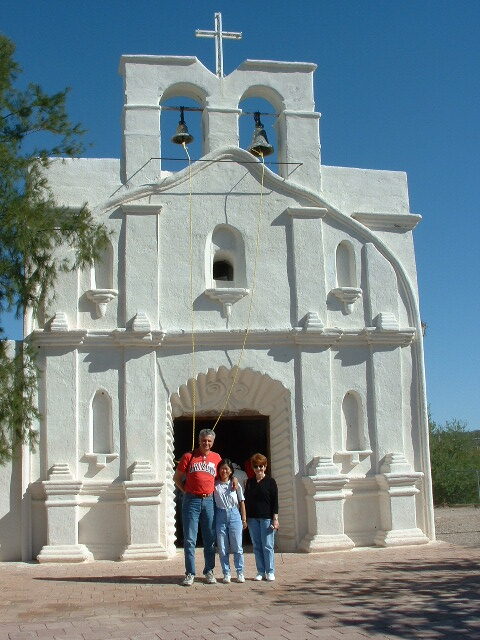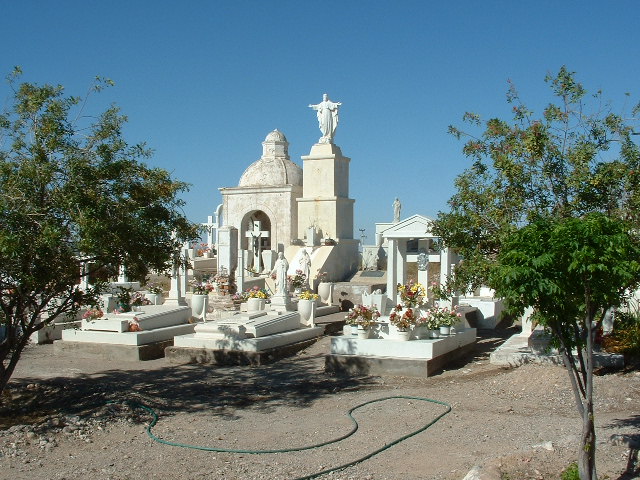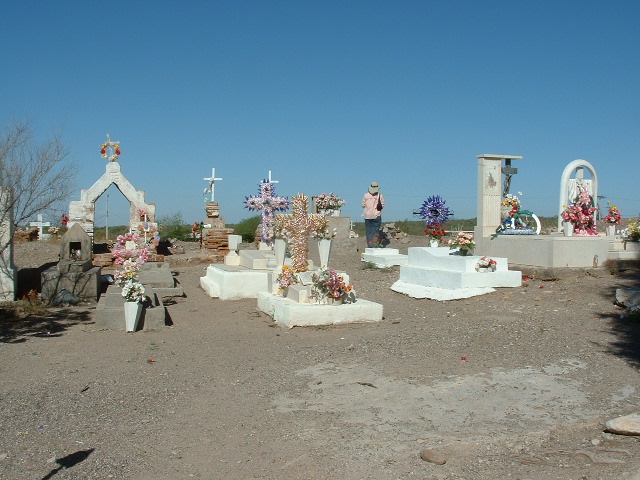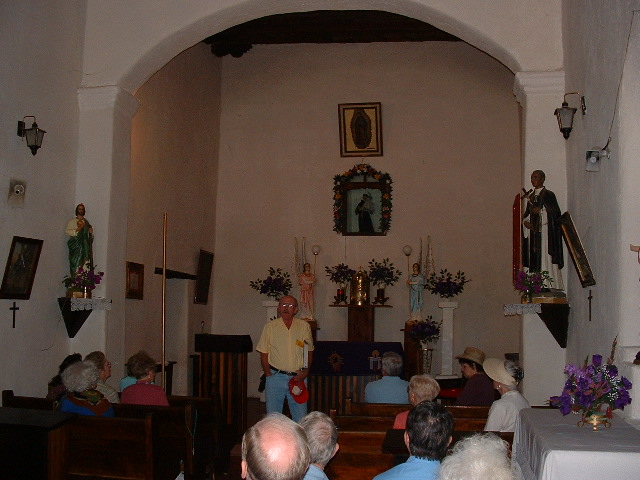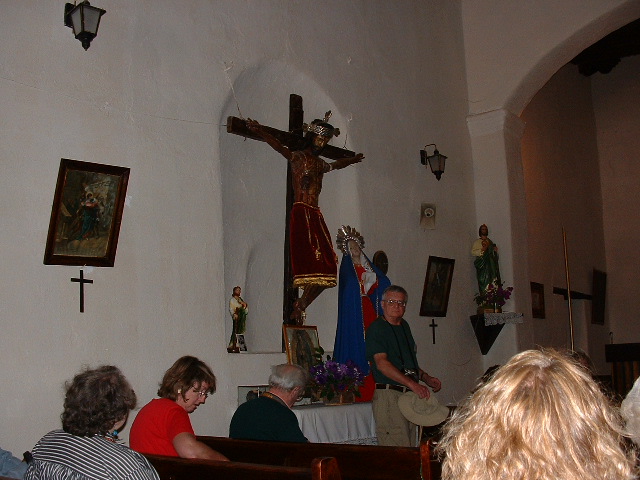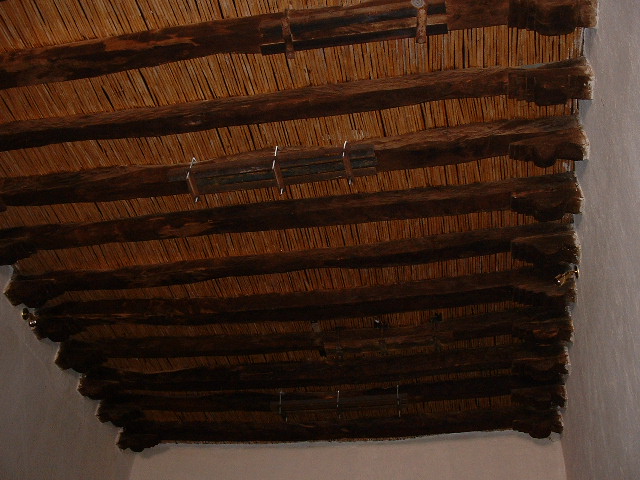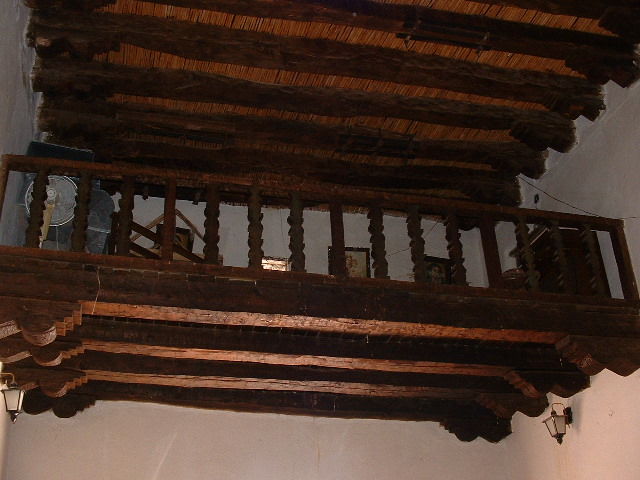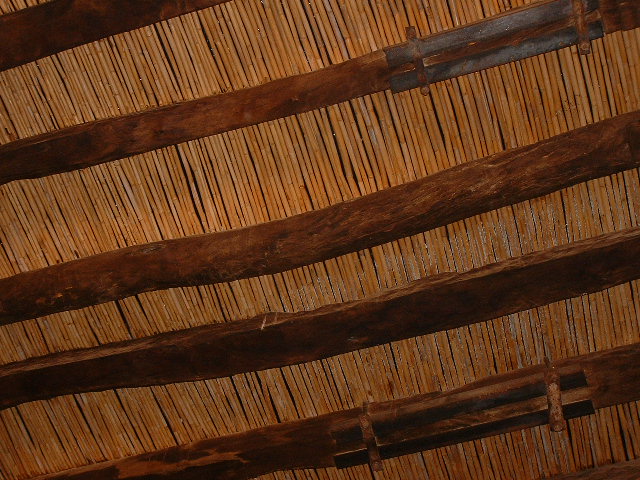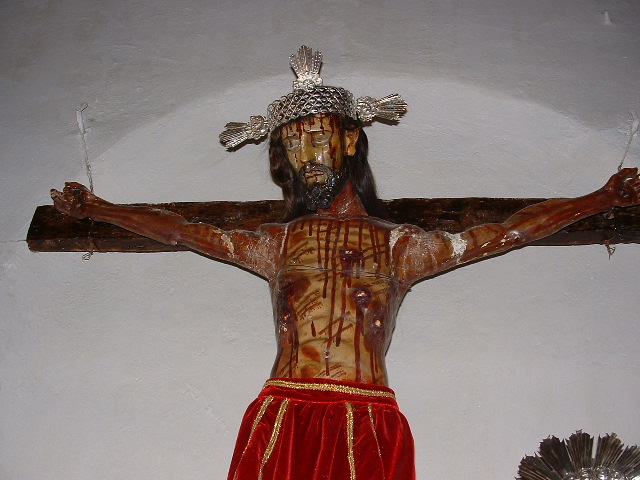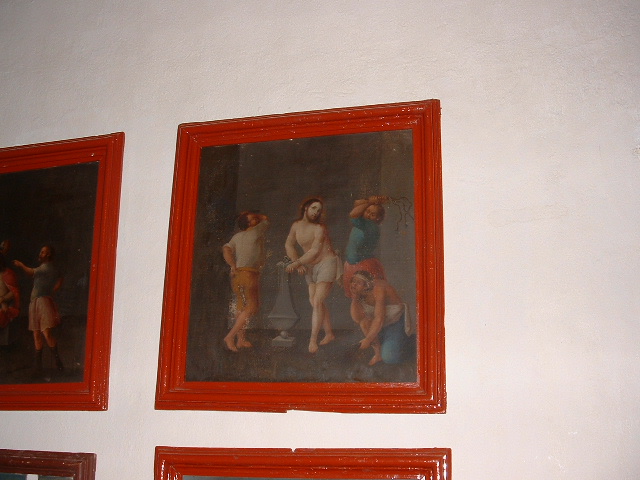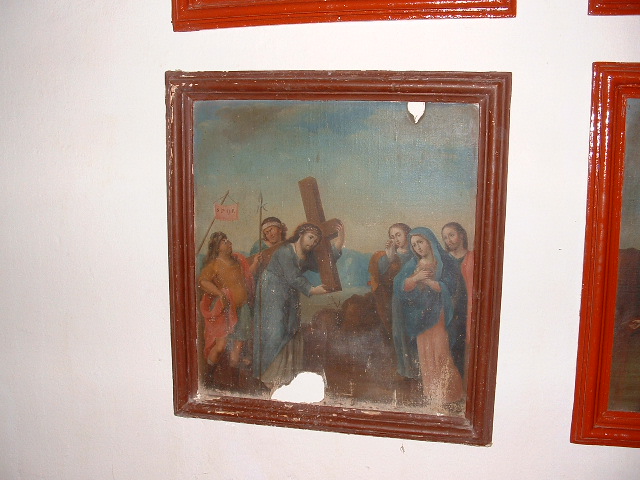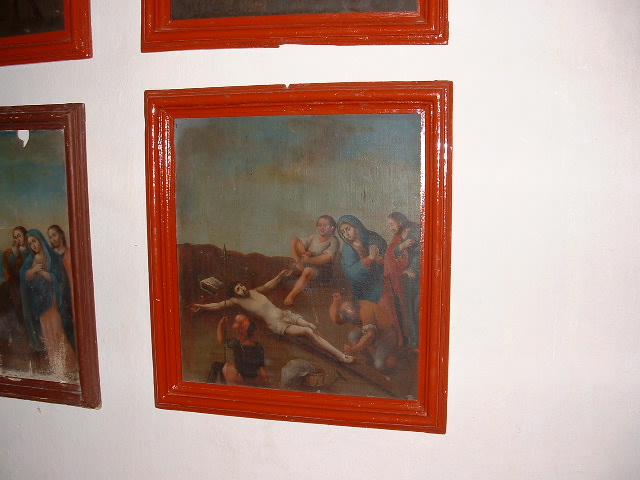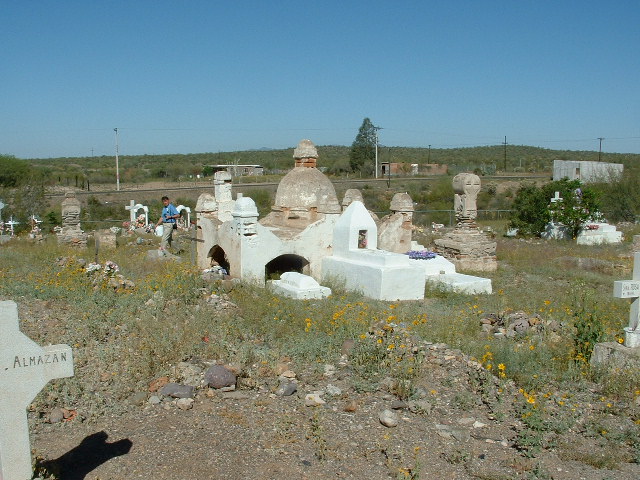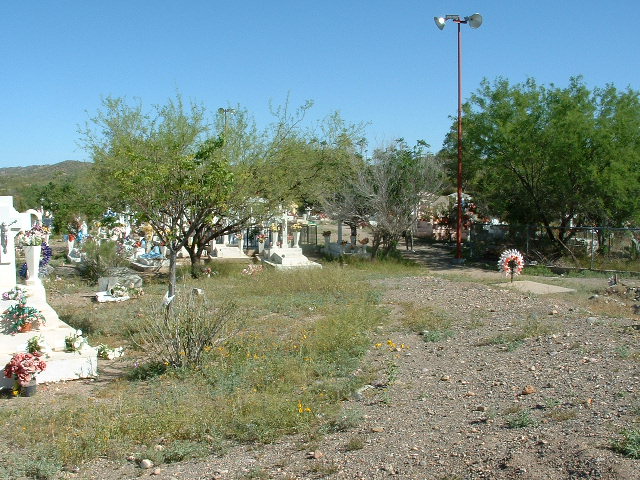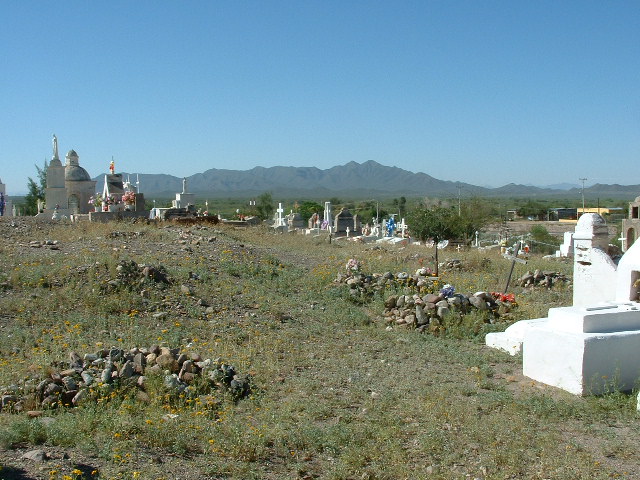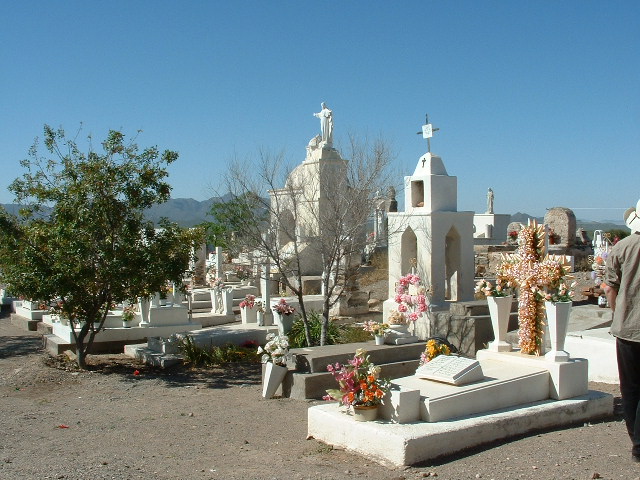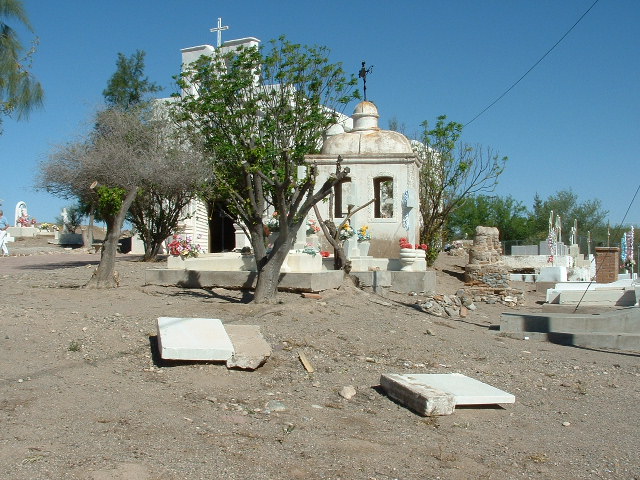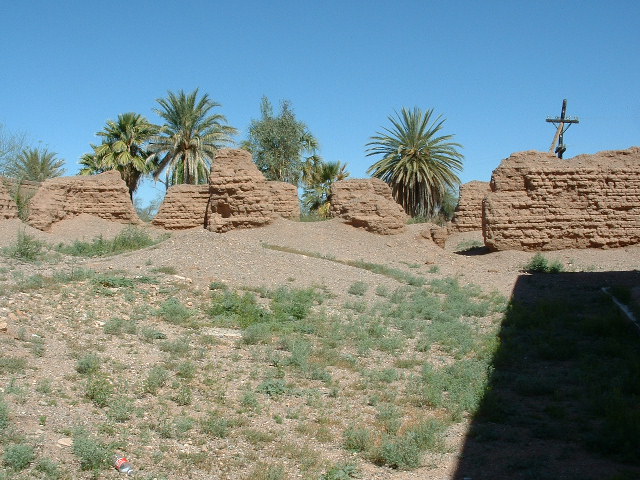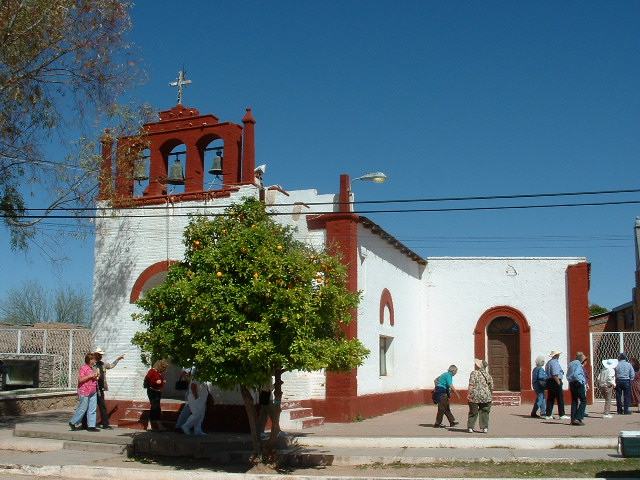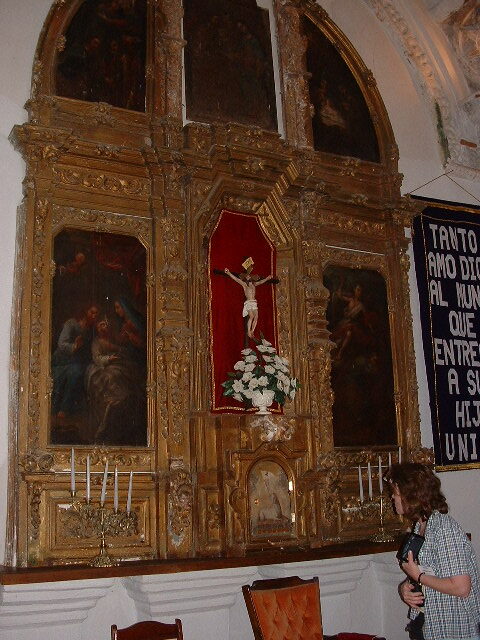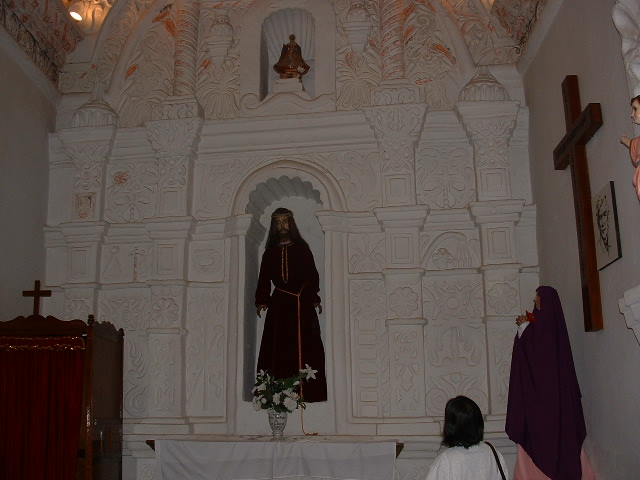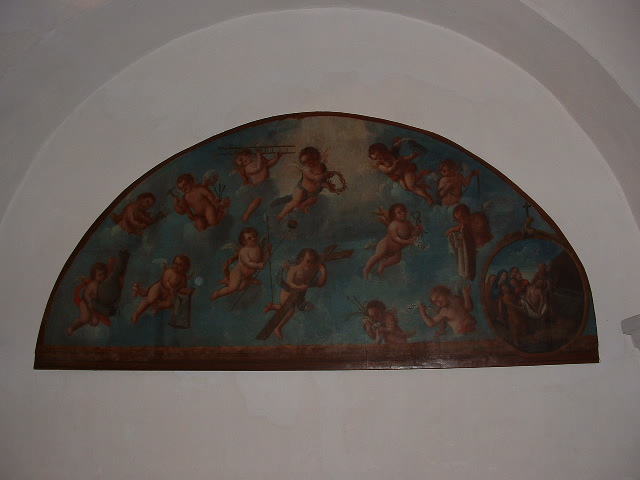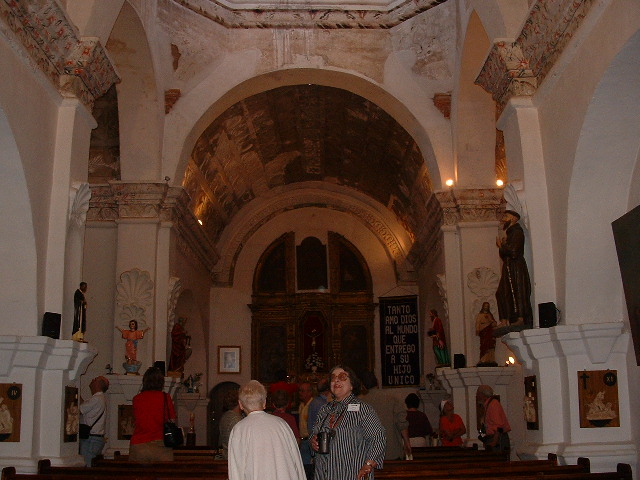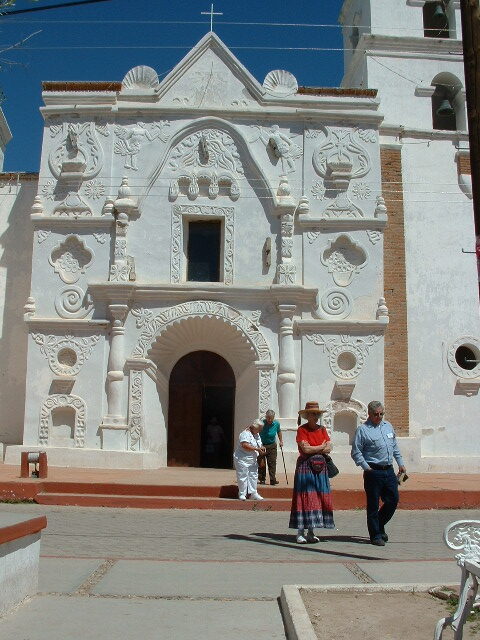Before reading this story, be sure to read the previous chapter, Part One.
It was Day 2 of our tour. After the excessive Happy Hour festivities of last evening, many of us started the day rather bleary-eyed. I have no recollection what we did for a breakfast that morning, but before long we once again boarded our bus and hit the road. It took us less than an hour to reach our first objective of the day, the small town of Oquitoa with its 500 inhabitants.
Originally a rancheria with a nearby silver mine at the confluence of two rivers, the Altar and the Magdelena, Oquitoa is considered by many to be the gem of the Kino missions. Father Kino first made mention of San Antonio de “Uquetoa” on January 19, 1689, when the Father Visitor Manuel Gonzales assigned Father Antonio Arias to be its first priest. In 1705 there was a small chapel but no other church was constructed until 1730. It was partially or mostly destroyed, however, during the revolt of 1751. The Franciscans gave the church a facelift as mentioned in diaries dating from 1788 and 1797. It was perhaps at this time that it received the Franciscan façade. Interestingly enough, it kept its flat- roofed Jesuit architecture – the only one among Kino’s missions with such a feature still standing today. Oquitoa’s first priest, Father Antonio Arias, gave his patron saint’s name, San Antonio de Padua, to the mission.
The mission community of Oquitoa is a few miles northeast of the town of Altar, on the south side of the road. Its church stands on a hill just west of the village, surrounded by a cemetery. In November, on the Day of the Dead, this becomes a sea of light, with multiple candles lit on or beside each grave. The next morning, many candles are burned out, but the entire space is brightened with hundreds of flowers.
Today there are only a few relics of the mission period. A baptismal font made of copper was unlike the typical stone and copper models of its day. Six pictures of the crucifixion were painted by Mexican artists in the early 1800s. The choir loft and two side windows were reconstructed in 1920. The doors are made of mesquite, as are the beams supporting the roof.
The church of San Antonio de Padua is a simple hall church with the door at one end and the altar at the other. It is the only mission church in the region that survives from the Jesuit period (pre-1767), though the later Franciscans added some architectural details. As you enter, you look up at the ceiling, which still has most of its original mesquite vigas or beams.
Indians from this village (whom the Spanish labelled Soba) were said to have been responsible for attacking Caborca in 1695 and martyring its Jesuit missionary, Francisco Javier Saeta (read more about this towards the end of Part One in this story). In 1723, the village lacked both a church and a house for the missionary. Seven years later, however, a chapel was reported to be under construction.
The Franciscan priest who served longest at Oquitoa was Fray Francisco Moyano who arrived from Átil around 1795 and remained until his death in 1818. In 1801, he succeeded Francisco Iturralde as Father President of the missionary priests in the Pimería Alta.
It is almost certainly this building, whose church and sacristy in 1797 provided “suitable rooms,” whose roof was of beams (as it is today), and which was “sheathed on the outside with brick and lime mortar,” that is seen today. A “beautification” project mentioned by Father Barbastro in 1788 and described by Father Yturralde in 1797 probably included the new brick façade with scalloped portal and, inside, the addition of a triumphal arch separating the nave from the sanctuary. Oquitoa may mean “white woman” in the Piman language. The mission is beautifully preserved, and still in use today. The village cemetery is also at Oquitoa, and it is truly beautiful. It has an active congregation in the small village.
I thought I’d mention this side story here. Only a few miles away, in the church in the town of Altar, can be seen this prayer plainly posted. I share it with you here because nowadays in this part of the world so many undocumented border-crossers are trying to enter the U.S. and happen to use Altar as a jumping-off point for their attempt.
Near the church’s altar (with its portrait of the Virgin of Guadalupe), a prayer printed on a standard exhorts parishioners to pray for their “migrant brothers.” The text reads: “Heart of Jesus, full of love and mercy, I pray for my migrant brothers. Have mercy on them and protect them because they suffer abuses and humiliations in their journey, they’re marked by most as dangerous, and marginalized for being foreigners. May we respect and value their dignity. Touch with your mercy the hearts of as many as we see pass by. Protect their families until they return to their homes, not with broken hearts, but with their hopes fulfilled.”
Anyway, back to Oquitoa. At some time around 1850 the village of Oquitoa was under attack by a mixed force of Seris, Papagos and Apaches, the Indian bands that populated the region. The church of San Antonio is on a hill to the west of the village, and it was there that the villagers made their stand. The walls were thick, and the building could hold the entire community. Sonora’s mission churches were sited and built to be defensible. According to the story, things were going badly for the folks in the church. It seemed that the next charge might well be the last and end in a general slaughter. All of a sudden, the attackers scattered and fled for no apparent reason. It was only later that the Oquitoans learned what had happened: the attackers had seen a rescuing column of soldiers led by a bald-headed officer wearing a gray cloak, had decided they were outnumbered, and ran off. The only problem was that nobody else had seen the soldiers, and that no relief party had been sent from the nearby presidio at Altar. Perhaps a miracle had occurred?
I was able to get some pretty good pictures of the church and cemetery, and I share them with you here.
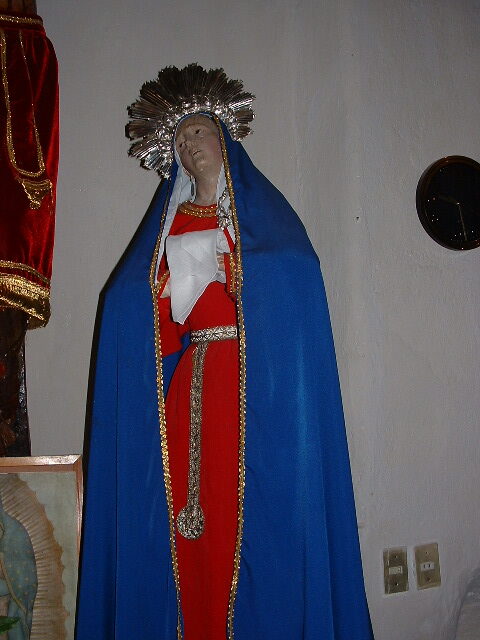
Another statue. It’s easy to see the high regard in which the villagers hold everything inside their church.
Inside the church is a group of paintings, painted directly on to the plaster walls back in the colonial period. It’s amazing that they have survived for centuries out in the open and unprotected like this.
Cemeteries fascinate me. Some of these burials look very old, and some quite ornate.
By 9:45 AM, our time at Oquitoa had come to an end. We piled back into our bus and drove northeast on Sonora Highway 43, to arrive at the village of Átil an easy half-hour later. This place is a perfect example of the old and new side by side. The mission was founded in 1687. Before the mission at Atil changed hands from the Jesuits to the Franciscans, it was called, “The Seven Archangels of Atil”.
What is known for sure is that the church and missionary’s residence at Átil, whose slowly melting adobe ruins can still be seen, were built under the administration of Father Jacobo Sedelmayr of Tubutama when Átil was its visita. This structure, although now in ruins, has special appeal in that it was the home base from 1756 to 1761 for one of Pimería Alta’s more literary Jesuit missionaries, Father Ignaz Pfefferkorn, whose “Sonora: A Description of the Province” is a regional classic.
Bishop Antonio de los Reyes on 6 July, 1772 wrote a report on the condition of the missions in the Upper and Lower Pimeria Alta. Following is his report on San Francisco de Átil as translated by Father Kieran McCarty:
The Mission at Áti, with one outlying mission station, is situated in a valley six or seven leagues long and two or three leagues wide, surrounded by high mountains, watered by an arroyo with good and plentiful water. Four leagues to the east and a little to the north lies the above-described Mission at Tubutama and seven leagues to the west and a little to the south, the Presidio of Altar. The village at Áti might well be the most pleasant and prosperous settlement of Upper Pimería but its products at the present time have dwindled to whatever the Indians individually and communally wish to produce, which is very little or nothing at all. The equipment in the sacristy consists of a chalice of silver, a copper censer, three old chasubles, an alb, an amice, and other adornments almost unserviceable for the altar and divine services. According to the Census Book, which I have here before me, there are thirty-six married couples, seven widowers, two widows, fifteen orphans, the number of souls in all one hundred thirty-seven.
In 1797, when Father Francisco Yturralde made his official visit, Átil had two resident missionaries. The walls and floor were of adobe and the roof was made of wooden beams.
When we arrived at Átil, the guides directed our attention to the adobe ruins – this is now all that remains of the original mission church founded in 1687. Unprotected like this, rains will continue to dissolve the old adobe bricks until nothing remains.
Here is the new church at Átil – this is what you see if you visit today.
The church at Átil was a brief stop, just long enough to take a few pictures and have a quick look around.
One of the most memorable stops of the entire trip was the mission of San Pedro y San Pable de Tubutama. Founded in 1691 by Father Kino, Tubutama was once the headquarters of all mission activity in the Pimería Alta. The architecture at Tubutama is much more ornate than the other missions we visited. Research indicates that it is constructed in the Mudéjar style of Islamic architecture that was common in medieval Spain.
Look at the idyllic scene in the above photo. Our bus stopped under some shady trees, where some lovely Mexican ladies had set up tables and chairs. They had prepared a hot meal of beans, rice, tortillas and other items. And of course, our tour guides had set up the omnipresent coolers filled with ice and drinks. It was a beautiful shady spot under tall trees, a very relaxed and comfortable atmosphere. As the four of us in our little group sat enjoying the delicious food, our attention was drawn to another of the nearby tables. There sat 2 ladies who were obviously older than us, at least in their seventies, and they were all enjoying ice-cold bottles of Pacífico beer. Ah, yes, the beer flowed like water on our tour, one of the strongest memories that still lingers. After lunch, we headed over to the church for a visit.
The original mission complex was destroyed in 1695 in the Pima Revolt. The missionary then in residence, Daniel Januske, was absent during the attack. The church was rebuilt in 1699, and again in 1706. It was destroyed again in 1751 in the second Pima Revolt, while under the supervision of Jacobo Sedelmeyr. His successor, Luis Vivas, saw it rebuilt by 1764. (The church in Caborca was also destroyed during the rebellion).
Antonio de los Reyes, on 6 July, 1772 submitted a report on the condition of the missions in the Upper and Lower Pimería Alta. This was his report on Tubutama as translated by Kieran McCarty:
The Mission at Tubutama, with one outlying mission station, lies eight leagues to the west and a little to the north of the Mission of Sáric. To the south lies the uninhabited land of Lower Pimeria and to the north are the Papagos and the other pagan nations up to the Colorado and Gila Rivers, some seventy leagues distance from this Mission.
The village at Tubutama is situated on a broad lowland of good and fertile fields where few Indians cultivate their individual fields and communally plant wheat, Indian corn, beans and other crops. The house of the Father Missionary is decent and roomy with an adjoining garden of quinces, pomegranates, peaches, and other trees. The church is interiorly adorned with two altars, paintings in gilded frames, and a small side chapel. In the sacristy are three chalices, a pyx, a ceremonial cross, ceremonial candle-holders, censer, three dishes and cruets, all of silver, vestments of every kind and color and other interesting adornments for the altar and divine services. According to the Census Book, which I have here before me, there are forty-five married couples, twelve widowers, six widows, eighteen orphans, the number of souls in all one hundred seventy-six.
Felipe Guillén served as resident missionary from 1774 until he was killed by Apache raiders in 1778. Francisco Antonio Barbastro oversaw yet another rebuilding in the 1780s.
The arched entrance reflects the Mudéjar style of Islamic architecture; however, the interior transept is dedicated to the Passion of Christ, and the altarpiece has sculptured instruments of the Passion: crown of thorns, scourge, nails, tongs, ladder, and lances. A sculptured serpent crawls beneath an upper niche in the same altarpiece. This recess now holds a carved statue holding an image of the Blessed Virgin Mary at Arantzazu in the Basque Country of northern Spain.
The church had a rocky start, being built and destroyed five times, the first in the 1690s and the last during the Pima Rebellion in 1751 (the church in Caborca was also destroyed during the rebellion).
But despite setbacks, the mission church still maintained its prominence through the Sonora missions era. It was the administrative headquarters for the missions of the Pimería Alta region for many years during the Jesuit and Franciscan eras. Jesuit priests gathered there in 1767 after the King of Spain expelled them from Spanish territories. It became the administrative headquarters for the Franciscans when they arrived in 1768.
The Franciscans built the current church during a period from the 1770s to the end of that century, during a time of frequent Apache raids. It is a marvelous example of period architecture with some unique characteristics that make it a must-see on Kino missions tours.
The footprint of the Iglesia de San Pedro y San Pablo is shaped like a cross, but instead of having an entrance at the base of the cross, the arched entrance is on one side, facing the plaza. This is because at the time of its construction, the pueblo of Tubutama was structurally arranged to provide a defense against Indian raids for the eight families who lived there. All of the homes were situated in a closed formation around the plaza, and their entrances, like that of the church, opened on the plaza side so the pueblo could be closed in a fortified position.
The building’s exterior façade features a vertically-mounted sun dial that is flanked by two large scallop shells, a symbol that represents Saint Santiago, the patron saint of Spain. Shells are symbols that are commonly used in Sonoran missions and also symbolize pilgrimage. Below and on either side of the sun dial are two angels, both carrying a rooster. Roosters are a common symbol used to represent Saint Peter, with the significance of his three denials of Christ before the first rooster’s crow in the morning.
Inside the church, simple wood pews still seat parishioners for church services, and a balcony is located at the back of the sanctuary. It has been undergoing a steady, detailed renovation for years, so many of the restored areas have yet to be re-painted. In front of the church, an arched ceiling over the altar area is filled with bas-relief symbols in plaster. The wall behind the altar is a structure of woodcarvings that date back to the late 1700’s with five inlaid oil paintings depicting scenes in the life of San José, Saint Joseph.
The ceiling in front of the altar area features a domed copula. On both sides of the copula are the two transepts that form the cross-sections of the cross. The transept on the left side of the altar features a figure of San Francisco Javier, a statue of the Passion of Christ and higher up a smaller figure of Our Lady of San Juan de los Lagos. The wall is adorned with bas-relief designs formed in plaster.
The opposite transcept features a figure of the Virgin Mary as the Basque saint Our Lady of Aránzazu, and a brass baptismal font with a decorative dove handle. Its wall is also decorated with three-dimensional plaster designs. There are also some interesting religious figures in the sanctuary, like the life-sized figure of Christ on the cross, Santa Eduviges carrying a basket of bread, a statue of Saint Francis of Assisi and a purple-frocked Santa Dolores, Our Lady of Sorrows.
The church has an adjoining museum with church relics like centuries-old woodcarvings of saints and historic, decorative, priestly vestments. But the museum is only open on request, so you need to either be on an organized tour or ask around to find the home of the very friendly woman who has the keys. I wish I had taken more photos here, but for some reason only have these few.
There was so much splendid detail at Tubutama, you could spend days taking it all in. Unfortunately, we only had a short time there before having to move on.
To be continued, as: The Kino Missions Tour – Part Three.

